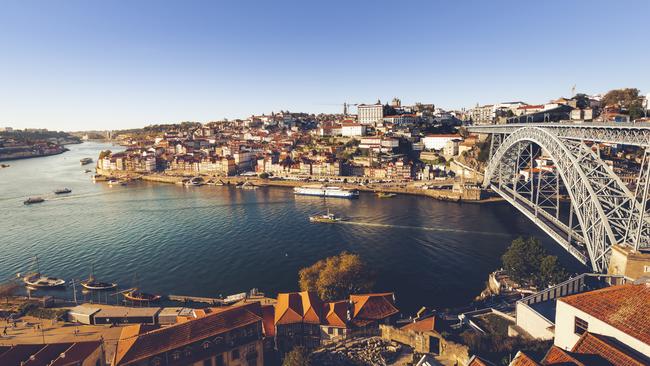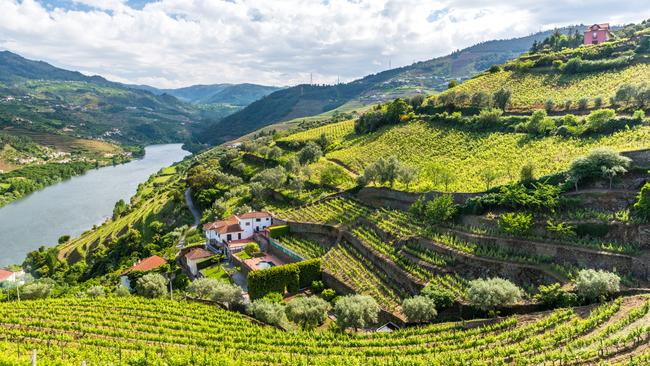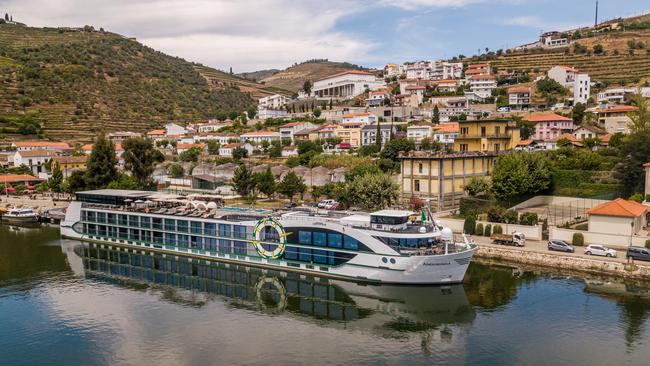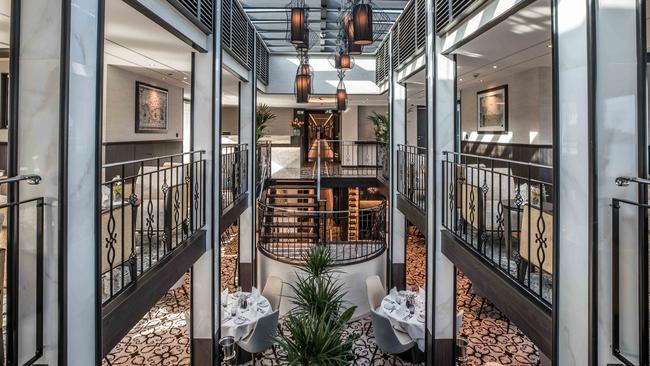Douro Valley river cruise
History, wine and fellowship converge on a cruise along Portugal’s famed river.

This is a story about two journeys: one, a gentle river cruise through Portugal’s majestic Douro Valley, the other a voyage from preconception to the pleasures of an open mind. Seeing the world from a ship – at a distance and sharing space with several hundred others day after day – had always seemed odd to me, so the prospect of a river cruise from Porto in the country’s northwest to the border with Spain in the south, filled me with as many questions as excitement.
Would I have anything in common with my fellow travellers? Could I spend a week minus the freedom of exploring a new place without a map, following my nose down an alleyway, or stopping to gaze at an unexpected vista? Wandering the narrow streets of Porto before embarkation, I feel a little like a prisoner in the last hours before the loss of freedom. I walk for six hours, forgetting to eat despite the lure of fragrant cafes and freshly cooked pastel de nata tarts, choosing instead to soak in the drama of the city’s many tall bridges, the sea of terracotta roofs, gelati-coloured buildings framed against a bright blue sky.

I brave vertigo on the iron Dom Luis I Bridge (not to be confused with the Gustave Eiffel-designed Maria Pia Bridge nearby), and poke my head into myriad picturesque courtyards, blue azulejos tile-covered churches and chapels. Porto turns out to be a revelation, a mix of the chaos and narrow cobbled streets of my favourite city, Naples, and a jaundiced Parisian elegance. I take in Rua das Flores, a vibrant street of jaunty boutiques, funky hotels, and gorgeous tiled facades, schlepp the nearly vertical rise to the Baroque cathedral of Clerigos (there is a free noontime organ recital most days), explore the perimeter of the graceful belltower and walk the nearby gardens and an olive grove planted into the roof of an arcade. The central produce market, Mercado do Bolhao, is a riot of colour, from enormous ruby mangoes and tiny emerald figs to the creative graphics of sardine tins and wine labels.
Porto is an intrinsically European city, yet the Moors’ influence in the 13th century and the legacy of great explorers of the 15th century, from Vasco da Gama to Ferdinand Magellan, imbues it with an exotic, mysterious flavour even half a millennium later. Traces of enormous past wealth are everywhere, mixed with the confronting remnants of the post-revolutionary “trash the old, buy new” development boom followed by an exodus of thousands of citizens. Over the decades, some of the city’s most graceful, old buildings were abandoned, the cost of upkeep too steep. Today, the traditional vernacular is being revalued, and cranes dot the streets as old buildings are gutted internally while their historic facades are maintained and restored.

Enthused and enthralled, and knowing there’s a guided tour with fellow Tauck passengers before sailing the following day, I return to the rendezvous point outside the hotel and, a short bus trip later, embark Andorinha. Built specifically for the Douro River in 2020, the ship was locked down until its maiden voyage in August last year. It displays a “small is big” ethos, offering luxurious berths to a maximum of 84 guests, one-third fewer than other ships cruising the river. Our Tauck cruise director, Joyce Adamidis, and three guides, Manuel, Susana and Daniela, introduce us to the two restaurants, including one on the sun deck, which retracts hydraulically as the ship enters a lock or passes under a low bridge, plus the turquoise pool and marble-floored, glass-walled panorama lounge and bar. When I’m shown my stateroom, complete with coffee machine, minibar and marble walk-in shower, and gaze out the huge, sliding glass doors, my cruise anxiety dissipates into the deep green of the river.
Over the next seven days, Andorinha, named after the native migratory swallows that return to Portugal every spring, sails past scenery that reduces even the most loquacious passenger to a reverential quiet. Vast, granite cliffs coated in fluorescent lichen give way to soft, undulating hills punctuated by the silvery green of olive trees and a sea of grape vines blushing with the reds of early autumn.

Unlike the drystone terraces of southern Italy or France, the Douro Valley is shaped predominantly by granite and shale, and its 44,000ha of vineyards nestle into steppes hewn into the rock. Before 1860, grapes had been planted into hand-built terraces and buttressed walls. In the decades after 1868, when an infestation of phylloxera aphids devastated the region, vineyards were rebuilt into the long, continuous terraces seen today. From above, the valley looks as if a giant has thrown a boulder into a pond, the curves of grapevines creating vast rows of ripples to the horizon. Landholders have produced wine here for 2000 years, and nowhere is the hand of man more visible in the natural landscape than in the peaks and troughs of the region, granted World Heritage listing by UNESCO in 2001.
A microclimate created by the Marao and Montemuro mountains means this Atlantic environment is more like the Mediterranean, hot in summer, mild in spring and autumn. We are sailing in October and have just one day of rain; gentle showers and grey skies accentuate those innumerable shades of green.
Captain Casimiro Matos explains that Andorinha sails only during the day as the river is notorious for its treacherous waters and narrow bends. In some places, the Douro’s depth is just 2m; in others, it plunges to 50m. Over the centuries, many men who sailed in the traditional flat-bottom Rabelo boats to transport the Douro Valley’s finest wines to Porto lost their lives in its unpredictable floods and flows. Today, a series of enormous locks, one of which is 35m high, ease navigation.

Over the week, as we sail past characteristically white-walled villages and houses built midway up the valley sides, it’s evident the constantly changing views make river sailing very different to open-sea cruising. Oceans and endless horizons can be mesmerising, but every day on the Douro brings something fresh and new, from church steeples and roads snaking into mountains to a train line that follows the riverbank and looks like a Hornby toy. Abandoned houses and crumbling ruins remain as grim evidence of the devastating phylloxera epidemic, while tiny, private chapels nestled among clusters of farm buildings are signposts for the major winery estates known as the Douro Quintas. Sharing such beauty means easy bonding and conversation with fellow passengers, happy to sit in clusters and watch the landscapes sail past.
The Douro’s cultural offerings are sophisticated and well-designed, particularly for a region still in its relative infancy as a tourist destination. In the little village of Peso Da Regua, a cleverly curated museum traces the river’s history and ancient winemaking in the region, but the real tour de force is the monumental Coa Museum and Archaeological Park, which sits on a hill atop the mouth of the Coa River. In 1991, during construction of the Coa Dam, archaeologist Nelson Rebanda discovered a first panel of palaeolithic rock art. When the find was publicly announced in 1994, it sparked huge controversy but, luckily, student demonstrations and an ultra-fast UNESCO classification pushed the government to abandon the dam.
Today, there are 80 rock art sites and more than 1300 panels over 200km, making it the largest open-air site in the world. The spectacular museum, set atop the mountain like a huge slate slab, opened in 2020 and houses replicas; aided by digital projection, they reveal brilliantly the carvings said to be man’s first attempt at depicting movement. The three major open-air art sites can be visited at particular times of the day when sunlight is optimal via guided hikes or kayaks and a return visit is already on my bucket list.
Tauck has a long history cruising in Europe and the Douro and has forged fascinating and exclusive relationships with wineries and port cellars. A formal tasting dinner prepared by chef Milton Ferreira and paired with oenologist Paulo Coutinho’s carefully selected wines in the family-run Quinta do Portal in Pinhao is a highlight. Over the following days, we also amble the cobblestone streets of Amarante, first settled in the 4th century BC and home to the sparkling and delicious young vinho verde wines unique to the region. We ride bikes for 15km along a disused railway track, over soaring bridges and through patchworks of smaller vineyards.

On board each day, chef-prepared culinary delights using fresh produce range from Portuguese cod specialties to fresh oysters and a chocolate afternoon tea. We taste more local wines, and cocktails such as Porto Spritz, a delightful innovation of white port with tonic. However, for me, there are two very special moments on board. The first is an intriguing lecture by young tour director Manuel Rezende on the unique Portuguese concept of Saudade, followed by a moving account by his Spanish colleague, Susana Olivares, of her childhood growing up amid the terror and poverty forced by dictator Francisco Franco.
Manuel, wry, intelligent and blessed with a quick wit and sense of humour, conveys eloquently in English (not his native language) the complexities of the emotional state of longing encapsulated by Saudade and its influence on the Portuguese national identity, its music and culture. With remarkable emotional courage, Susana shares a familial story in which great love and togetherness triumphed over the horror of surviving fascism, unexplained disappearances and deaths, living with constant hunger and paralysing fear.
I may have boarded Andorinha fearful of being stifled but depart enlightened, enthused and buoyed by new friends.
In the know
All-inclusive fares for an eight-day Tauck Douro River cruise, round-trip from Porto on August 4, 2023, start at $7030 a person, based on double occupancy in a category-one suite and subject to availability. No single supplement charges apply if booked before the end of 2022. More: 1800 962 043.
Paola Totaro was a guest of Tauck.

To join the conversation, please log in. Don't have an account? Register
Join the conversation, you are commenting as Logout